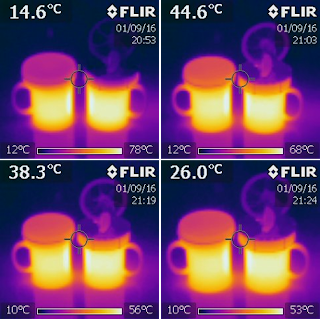 |
| Figure 1 |
The year 2016 marks the 200th anniversary of an important invention of Robert Stirling — the Stirling engine. So I thought I should start this year’s blogging with a commemoration article about this truly ingenious invention.
A Stirling engine is a closed-cycle heat engine that operates by cyclic compression and expansion of air or other gas by a temperature difference across the engine. A Stirling engine is able to convert thermal energy into mechanical work.
You can buy an awesome toy Stirling engine from Amazon (perhaps next Christmas’s gift for some inquisitive minds). If you put it on top of a cup of hot water, this amazing machine will just run until the hot water cools down to the room temperature.
 |
| Figure 2 |
Curious about whether the Stirling circle would actually accelerate the cooling process, I filled hot water into two identical mugs and covered one of them with the Stirling engine. Then I started the engine and observed what happened to the temperature through an IR camera. It turned out that the mug covered by the engine maintained a temperature about 10 °C higher than the open mug in about 30 minutes of observation time. If you have a chance to do this experiment, you probably would be surprised. The flying wheel of the Stirling engine seems to be announcing that it is working very hard by displaying fast spinning and making a lot of noise. But all that energy, visual and audible as it is, is no match to the thermal energy lost through evaporation of water from the open hot mug (Figure 1).
How about comparing the Stirling engine with heat transfer? I found a metal box that has approximately the same size and same thickness with our Stirling engine. I refilled the hot water to the two mugs and covered one with the metal box and the other with the Stirling engine. Then I started the engine and tracked their temperatures through the IR camera. It turned out that the rates of heat loss from the two mugs were about the same in about 30 minutes of observation. What this really means is that the energy that drove the engine was actually very small compared with the thermal energy that is lost to the environment through heat transfer (Figure 2).
This is understandable because the speed of the flying wheel is only a small fraction of the average speed of molecules (which is about the speed of sound or higher). This investigation also suggests that the Stirling engine is very efficient. Had we insulated the mug, it would have run for hours.
3 thoughts on “An infrared investigation on a Stirling engine”
Comments are closed.
Thank you for posting this. Very interesting. I would like to see a similar experiment with a Stirling running on ice.
I got a Stirling engine kit and tried a similar experiment to see how long the engine would run on a mug of ice, if the ice were completely insulated from the surrounding air as you suggested. Would it run for hours?
Yes!
I don’t know the conclusion yet as the engine is still running! (But very slowly). So far it has been running 31 hours.
https://youtu.be/s4MzYMen2Ow
If left uncovered quite a bit of condensation accumulates on top of the engine.
https://youtu.be/-7zntz8kwIk
Oh, there is another video I forgot, when I first started the experiment :
https://youtu.be/dQVRVL1OUBg
After it ran for several hours I added more insulation.